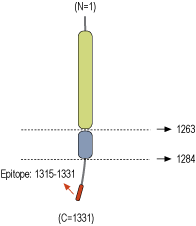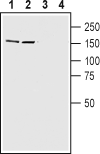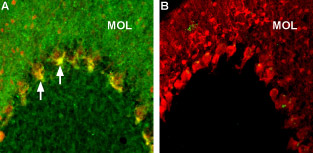Overview
- Peptide (C)DPNFTETIDESKKEWLI, corresponding to amino acid residues 1315-1331 of human Caspr2 (Accession Q9UHC6). Intracellular, C-terminus.

 Western blot analysis of rat (lanes 1 and 3) and mouse (lanes 2 and 4) brain lysates:1,2. Anti-Caspr2 Antibody (#APZ-005), (1:200).
Western blot analysis of rat (lanes 1 and 3) and mouse (lanes 2 and 4) brain lysates:1,2. Anti-Caspr2 Antibody (#APZ-005), (1:200).
3,4. Anti-Caspr2 Antibody, preincubated with Caspr2 Blocking Peptide (#BLP-PZ005).
 Expression of Caspr2 in rat cerebellumImmunohistochemical staining of rat brain frozen sections using Anti-Caspr2 Antibody (#APZ-005), (1:200), (green). A. Caspr2 appears in pinceau structures (arrows) and diffusely in the molecular layer (MOL). Staining of the same section for parvalbumin (red) labels Purkinje cells and demonstrates the position of the pinceau under Purkinje cells. B. Pre-incubation of the antibody with the Caspr2 peptide antigen blocks the staining, demonstrating specificity.
Expression of Caspr2 in rat cerebellumImmunohistochemical staining of rat brain frozen sections using Anti-Caspr2 Antibody (#APZ-005), (1:200), (green). A. Caspr2 appears in pinceau structures (arrows) and diffusely in the molecular layer (MOL). Staining of the same section for parvalbumin (red) labels Purkinje cells and demonstrates the position of the pinceau under Purkinje cells. B. Pre-incubation of the antibody with the Caspr2 peptide antigen blocks the staining, demonstrating specificity.
- Poliak, S. et al. (1999) Neuron 24, 1037.
- Craig A.M. and Kang Y. (2007) Curr. Opin Neurobiol. 17, 43.
- Poliak, S. et al. (2003) J. Cell Biol. 162, 1149.
- Strauss, K.A. et al. (2006) N. Engl. J. Med. 354, 1370.
- Friedman, J.I. et al. (2008) Mol. Psychiatry 13, 261.
- Alarcon, M. et al. (2008) Am. J. Hum. Genet. 82, 150.
Contactin-associated protein 2 (Caspr2) is a member of the neurexin superfamily, a group of transmembrane proteins that mediate cell–to-cell interactions in the nervous system1,2.
Neurexins are adhesion molecules expressed mainly at presynaptic locations that form trans-synaptic cell–to-cell adhesion complexes via binding to their postsynaptic partners, the neuroligins2.
Caspr2, like other neurexin proteins, is a type I membrane protein that contains epidermal growth factor repeats, laminin G domains, an F5/8 type C domain, and fibrinogen-like domains in its extracellular domain1,2.
Caspr2 is localized at the juxtaparanodes of myelinated axons, a specialized region that mediates interactions between neurons and glia during nervous system development1.
The juxtaparanodal region is highly enriched with heteromultimers of the K+ channels KV1.1, KV1.2, and their cytoplasmic KVβ2 subunit, which may help in axon conduction stabilization and the maintenance of the internodal resting potential1. Caspr2 is essential for the targeted localization of these channels in the juxtaparanodal regions. Indeed, targeted disruption of Caspr2 resulted in a marked reduction in the accumulation of K+ channels at the juxtaparanodes in both peripheral and central nervous system axons3.
Moreover, mutations in the Caspr2 gene have been implicated in multiple neurodevelopmental disorders, including Tourette syndrome, schizophrenia, epilepsy, autism, attention-deficit hyperactivity disorder and mental retardation4-6.
Application key:
Species reactivity key:
Alomone Labs is pleased to offer a highly specific antibody directed against an epitope of human Caspr2. Anti-Caspr2 Antibody (#APZ-005) can be used in western blot and immunohistochemistry analysis. It has been designed to recognize Caspr2 from rat, mouse and human samples.
Applications
Citations
- Mouse sample:
Savvaki, M. et al. (2010) J. Neurosci. 30, 13943.
- Mouse sample:
Savvaki, M. et al. (2010) J. Neurosci. 30, 13943.
